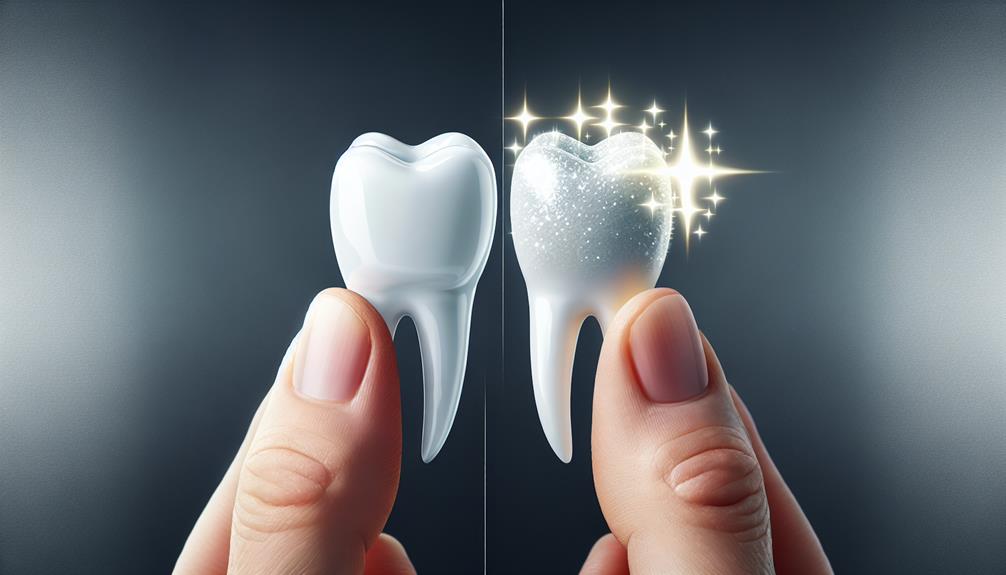DIY whitening methods work for stained teeth because they are cost-effective, incorporate natural remedies, and make use of everyday household items that gently eliminate stains. Ingredients like baking soda, hydrogen peroxide, strawberries, and coconut oil provide safe and effective alternatives to harsh chemicals commonly found in professional treatments. These DIY approaches not only help maintain a brighter smile without breaking the bank but also offer a more natural and gentle way to improve the appearance of your teeth. Find out more about common DIY whitening ingredients, safe practices, sensitivity management, and ideal results to enhance your knowledge and achieve the best outcome.
Key Points
- Ingredients like baking soda and hydrogen peroxide remove surface stains effectively.
- Natural remedies like strawberries and coconut oil combat discoloration gently.
- DIY methods use safe ingredients to whiten teeth without harsh chemicals.
- Regular use maintains a brighter smile while being gentle on enamel.
- Cost-effective solutions for stained teeth with long-term results.
Benefits of DIY Whitening Methods
Discover the advantages of utilizing at-home whitening techniques for achieving a brighter smile. DIY whitening methods offer cost-effective solutions compared to professional treatments. These natural remedies can help you achieve a whiter smile without breaking the bank. By using common household ingredients, you can create effective whitening solutions that are gentle on your teeth and gums.
One of the primary benefits of DIY whitening methods is their cost-effectiveness. Professional whitening treatments can be expensive, making it challenging for some to afford regular sessions. With at-home whitening techniques, you can achieve similar results at a fraction of the cost. Additionally, natural remedies used in DIY whitening methods are often gentler on your teeth, minimizing the risk of sensitivity or damage.
Incorporating cost-effective solutions and natural remedies into your oral care routine can help you maintain a brighter smile without straining your budget. By exploring DIY whitening methods, you can enjoy the benefits of a whiter smile while taking a more natural and affordable approach to oral care.
Common DIY Whitening Ingredients
When seeking to whiten your teeth using do-it-yourself methods, common ingredients found in your kitchen can be effective and safe. Incorporating natural remedies and household products can help brighten your smile without harsh chemicals. Here are some common DIY whitening ingredients you can easily find at home:
- Baking Soda: Known for its gentle abrasive properties, baking soda can help scrub away surface stains on teeth.
- Hydrogen Peroxide: This common household antiseptic can act as a bleaching agent, helping to whiten teeth effectively.
- Strawberries: Containing malic acid, strawberries can help remove stains on teeth when mashed and applied as a paste.
- Coconut Oil: Oil pulling with coconut oil can reduce bacteria in the mouth, leading to fresher breath and potentially whiter teeth over time.
Safe Practices for DIY Whitening
To guarantee the safety and effectiveness of your DIY whitening efforts, it's important to follow recommended practices for whitening your teeth at home. Precautionary steps are essential before starting any DIY whitening treatment.
In the first place, consult with your dentist to confirm your teeth and gums are healthy and suitable for whitening. It's crucial to read and follow the instructions provided with the whitening product meticulously. Avoid overusing whitening solutions, as this can lead to enamel damage and tooth sensitivity.
Application techniques play a crucial role in achieving desired results without causing harm. Use a designated teeth-whitening applicator or brush to ensure even coverage and prevent excessive product contact with your gums. If using trays, make sure they fit properly to avoid leakage of whitening gel onto your gums, which can cause irritation.
Managing Sensitivity With DIY Methods
If you experience sensitivity while using DIY whitening methods, consider applying desensitizing toothpaste before and after treatments to help alleviate discomfort. Sensitivity prevention is crucial when engaging in at-home whitening procedures to guarantee a comfortable experience.
Here are some tips for managing sensitivity with DIY methods:
- Use a toothpaste designed for sensitive teeth: Opt for toothpaste specifically formulated to help with sensitivity, containing ingredients like potassium nitrate or strontium chloride.
- Avoid very hot or very cold foods: Extreme temperatures can exacerbate sensitivity, so try to consume foods and drinks at moderate temperatures.
- Limit whitening sessions: Overuse of whitening products can increase sensitivity; follow the recommended usage guidelines provided with the product.
- Consult your dentist: If sensitivity persists or becomes severe, consult your dentist for guidance on pain management and potential underlying issues.
Long-Term Results of DIY Whitening
For lasting outcomes from your DIY whitening endeavors, it's important to maintain good oral hygiene practices and adhere to recommended touch-up routines. Consistency in your oral care routine is vital to achieving and sustaining a brighter smile over the long term. When it comes to the effects on enamel, DIY whitening methods can potentially wear down the enamel if used excessively or if abrasive ingredients are involved. It's essential to strike a balance between achieving the desired whiteness and protecting your enamel's integrity.
Understanding the potential risks associated with long-term DIY whitening is significant. Overuse of whitening products or techniques can lead to increased tooth sensitivity, gum irritation, or uneven whitening results. To mitigate these risks, it's advisable to follow the instructions provided with the whitening products, avoid overuse, and consult with a dental professional if you experience any concerning symptoms. By being mindful of the effects on enamel and potential risks, you can enjoy a brighter smile without compromising your oral health in the long run.
Frequently Asked Questions
How Long Should I Wait Before Seeing Results From DIY Whitening Methods?
For quick results from DIY whitening methods, patience is key. Managing expectations is essential; realistic timeline varies. Typically, noticeable changes may occur within a week or two, but full results often take a few weeks.
Are DIY Whitening Methods Suitable for All Types of Stains on Teeth?
For persistent stains, DIY whitening methods may not be suitable. Some deep discolorations might require professional treatment for effective results. Consulting a dentist can help determine the best approach for your specific type of stain.
Can DIY Whitening Methods Cause Damage to Tooth Enamel?
When using DIY whitening methods, it's important to protect your enamel. Some DIY methods can lead to tooth sensitivity. To avoid enamel damage, consult with a dentist for safe whitening options tailored to your needs.
Are There Any Specific Dietary Recommendations to Follow While Using DIY Whitening Methods?
When using DIY whitening methods, it's important to maintain dietary restrictions for best effectiveness. Timing is key, so manage expectations accordingly. Remember, what you eat can impact the outcome, enhancing or hindering your results.
Can DIY Whitening Methods Be Used on Dental Work Such as Crowns or Veneers?
When it comes to DIY whitening, remember that dental work like crowns or veneers may have limitations. While some DIY alternatives can be effective for natural teeth, they may not work well on dental work.
Conclusion
To sum up, DIY whitening methods can be effective for stained teeth due to their ability to remove surface stains and brighten the smile. Like a skilled artist painting a masterpiece, these methods delicately enhance the natural beauty of your teeth. By using common ingredients safely and consistently, you can achieve long-lasting results while managing sensitivity.
Always remember to consult with a dental professional before beginning any whitening regimen for the best oral health.



